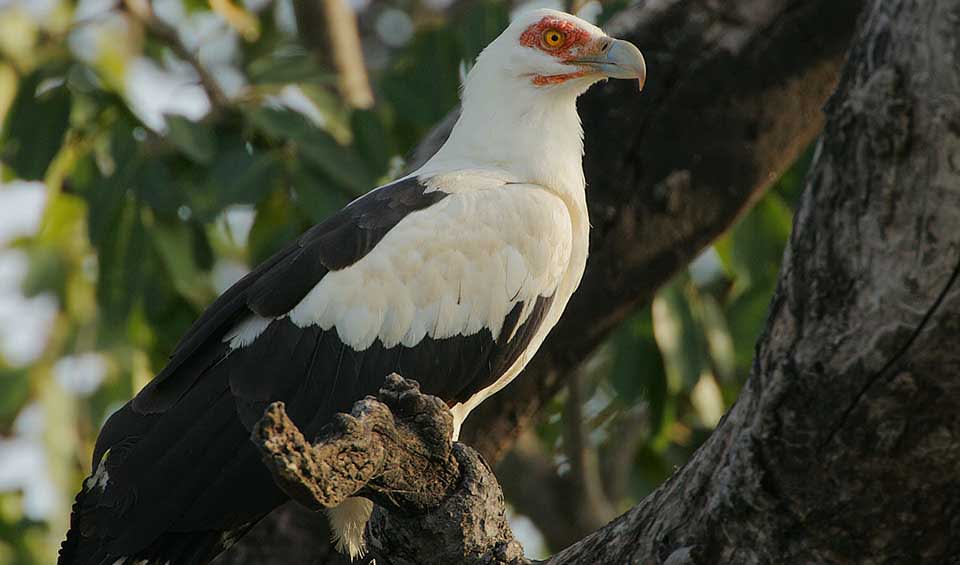One of Africa’s most unusual and fascinating birds of prey—mainly because it defies almost everything we expect from a vulture. Unlike its scavenging, meat-loving relatives, the palm-nut vulture is largely frugivorous, feeding primarily on the fruit of oil and raffia palms. This makes it one of the very few birds of prey in the world whose diet is mostly plant-based, and it thrives in the wetlands, riverbanks, coastal forests, and palm-dotted savannas of sub-Saharan Africa.
Adults have a bold look: mostly white with contrasting black flight feathers and tail, and a bare face and eye-ring that is bright red, adding to their vulture-like, somewhat prehistoric appearance. Juveniles, however, are mostly brown and look much more like typical birds of prey, only gradually developing their adult plumage over several years.
Despite being called a vulture, this species behaves more like a bald eagle or a sea eagle, especially in its flight style—soaring gracefully over wetlands and coasts on broad wings. It is most often found near water and palm trees, where it feeds on palm fruits, particularly the oily nuts of the raffia palm, which it swallows whole or rips apart with its strong, curved beak. While its diet is mostly fruit, the palm-nut vulture is not a strict vegetarian—it will also eat fish, crabs, dead animals, and small reptiles when available.
Palm-nut vultures are typically seen alone or in pairs, although they may gather in small groups around abundant food sources like fruiting palms. They are relatively quiet compared to other vultures, but may produce soft whistles or croaking sounds, especially during courtship or when alarmed.
Distribution
 Angola
Angola Benin
Benin Botswana
Botswana Burkina Faso
Burkina Faso Burundi
Burundi Cameroon
Cameroon Central Af. Rep.
Central Af. Rep. Chad
Chad Congo-Brazzaville
Congo-Brazzaville Côte D’ivoire
Côte D’ivoire DR Congo (Kinshasa)
DR Congo (Kinshasa) Equatorial Guinea
Equatorial Guinea Gabon
Gabon Gambia
Gambia Ghana
Ghana Guinea-Bissau
Guinea-Bissau Guinea
Guinea Kenya
Kenya Lesotho
Lesotho Liberia
Liberia Malawi
Malawi Mali
Mali Mozambique
Mozambique Namibia
Namibia Niger
Niger Nigeria
Nigeria Rwanda
Rwanda Senegal
Senegal Sierra Leone
Sierra Leone South Africa
South Africa South Sudan
South Sudan Sudan
Sudan Tanzania
Tanzania Togo
Togo Uganda
Uganda Zambia
Zambia Zimbabwe
ZimbabweAnything we've missed?
Help us improve this page by suggesting edits. Glory never dies!
Suggest an editGet to know me
Terrestrial / Aquatic
Altricial / Precocial
Polygamous / Monogamous
Dimorphic (size) / Monomorphic
Active: Diurnal / Nocturnal
Social behavior: Solitary / Pack / Herd
Diet: Carnivore / Herbivore / Omnivore / Piscivorous / Insectivore
Migratory: Yes / No
Domesticated: Yes / No
Dangerous: Yes / No




